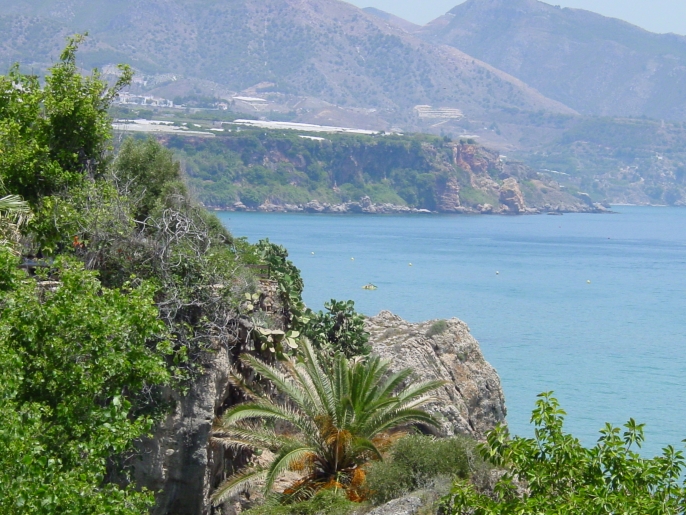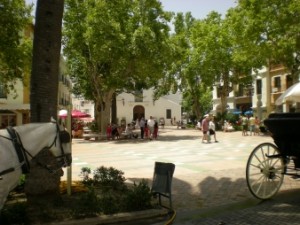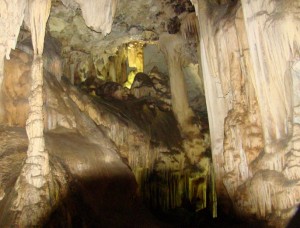The weather in Nerja – Ample amounts of fresh water, fertile soils, and a mild climate brought the first settlers to Nerja, but now the international thirst for second homes in warm surroundings has brought a new vibrancy to this very interesting area.
A Brief History of Nerja
Evidence of Prehistoric Settlement
The Caves of Nerja, approximately 5km from the town, were re-discovered in 1959 and continue to offer a wealth of information on the early history of the area. The caves were occasionally used by nomadic hunter gatherer groups around 27,000 years ago. Wild animals, including hyenas, vied with humans for occupancy in the ideally placed caves overlooking the plain between the coast and the foothills of the Sierra de Almijara. Paleolithic, and then Neolithic, Stone Age paintings have been discovered in the caves, these dating from around 23.000 years ago when human occupation became permanent. For around 15,000 years there was little change, although the diet became more varied to include fish, rabbits and goats. Around 6,000 years ago, domestication of livestock began to take place and primitive farming commenced aided by the production of simple pottery. The farming became more sophisticated and evidence of locally produced textiles has been uncovered. The caves appear to have been abandoned as dwelling places around 3,000 years ago.
Roman settlement of Detunda
The small Roman settlement of Detunda was discovered around 1km from the Caves of Nerja in what is now the present-day town of Maro. Coins and pottery of the Roman era suggested that this was a small stopping-off point for soldiers and land-based tradesmen moving between Almeria and Malaga. The remains of a Roman road still exist on the outskirts of Nerja.
Occupation of Southern Spain by the Moors
It was during the occupation of much of Spain by the Moors from the 8th to the 15th century that the first record of ‘Nerja’ appeared. An Arab poet wrote in the 10th century of Nerixa (meaning plentiful spring water) as a small well-run market town famous for it’s silks. Indeed, this era of Moorish rule brought a certain amount of stability and wealth to the region.
Christian Purges
The expulsion of the Muslins rulers from Iberia at the end of the 15th century led to widespread repression of the Andalusians by the Catholic authorities. The inhabitants of Nerja had to renounce their Muslim religion or be expelled. Many fled into the hills around Frigiliana, others followed as Berber raids from North Africa made coastal living increasingly unsafe. Nerja fell into decline despite repeated attempts to re-populate the area with Basques and other Catholics from northern Iberia, but farming continued on the surrounding plains.
Fortification of Nerja
Towers were constructed to fend off pirate Berber raids, and during the late 17th century a larger fortification was established on a coastal promontory in Nerja. This remained as a deterrent to erstwhile usurpers until the beginning of the 19th century. The Peninsular War (1808-1814) brought the British into conflict with Spain which, at the time, was largely under French control. In 1810, the British Fleet destroyed the defensive positions to prevent them falling under French control.
The Earthquake
On Christmas Day 1884 an earthquake occurred with an epicentre under Arenas de Rey near Granada. Flimsily constructed buildings were destroyed over a wide area and more than 800 people lost their lives. In early 1885 King Alfonso XII visited the area of devastation, and Nerja was included in his schedule. He promenaded the area known as La Bateria, where the old fortress once stood, and remarked on the view from the promontory. The ‘Balcon de Europa’ were words associated with the King, although the term was probably in local use before his arrival. Nevertheless, in later years, it was to become a valuable yarn for promoting tourism in Nerja.
Tourism arrived in Nerja….slowly
There was a gradual increase in tourism along the Costa del Sol during the early part of the 20th Century, but Nerja remained largely untouched. The small-scale fishing industry continued, and farming was the mainstay of the local community. Sugar-cane production became popular for a while but this declined as the growing of sugarbeet increased in northern Europe. Avocado groves flourished, and still do, and the forced growing of salad foods under glass, then plastic, provide a valuable contribution to the regional economy. Occasional tourists filtered along the coast to Nerja during the ’50s, and some stayed; but even in the ’60s when cheap package-style tourism boomed, the coaches nearly all drove west from Malaga Airport. During the ’80s, the penchant for second homes, especially amongst the British, led to a building boom. Fortunately, sensible planning permits, meant the excesses of high-rise development did not occur at Nerja. It is now a bustling town, with many second homes now becoming first homes, and a thriving ex-pat network exists.
General Climate and Weather in Nerja
The Sierra de Almijara rises to over 1800 metres to the north of Nerja, and this acts as a formidable barrier to the cold northerly winds that occasionally affect much of the rest of Iberia during the winter months. Rainfall is largely absent during the summer months, and with a regular afternoon sea breeze, the heat of inland Spain is seldom experienced. In fact, a survey suggests, that this part of the Costa del Sol experiences the best all-year-round weather in Europe.
Weather in Nerja in January
| Average Maximum 17C/63F | Average Minimum 9C/48F | Days with rain falling 7 |
There is usually plenty of sunshine during January and the rain, when it arrives, normally lasts, on and off, for 2 or 3 days before the sun returns for a week or more. Temperatures, although not especially high, do feel pleasant enough in the afternoon sunshine, On 2 or 3 days in the month, the temperature rises close to 20 Celsius (68F), but on the cloudy and wet days maxima may be no higher than 11 Celsius (52F). The evenings will almost always feel rather chilly, and on very rare occasions, the larger gardens on the outskirts of the town may have a frost on the grass for an hour or two around dawn.
Weather in Nerja in February
| Average Maximum 18C/64F | Average Minimum 9C/48F | Days with rain falling 6 |
This month can be described as early Spring, with flowers blooming and, by the middle of February, the famous Andalusian almond blossom begins to appear. Temperature levels are not dissimilar to those of January, and the evenings and nights remain rather cool. However, as the heat from the sun increases, the afternoon stroll down to the Balcon de Europa becomes more comfortably warm. Rain, as in January, usually comes in a spell that lasts for 2 or 3 days at a time before clear blue skies follow. It may turn breezy for a while after a wet spell, but strong winds are seldom a problem in this area.
Weather in Nerja in March
| Average Maximum 20C/68F | Average Minimum 11C/52F | Days with rain falling 5 |
Some delightful days occur in March but the early risers usually enjoy the best of the weather. A typical March day will start cool and sunny with a gentle wind blowing down from the Sierra de Almijara. Temperatures will rise rapidly and by noon values will be around 19 Celsius. A few clouds may form, then quite suddenly the wind will shift right round and blow in from the sea. The sea is as cold as at any time of year in March, so once the sea breeze has become established during the afternoon the promenade is best avoided. As for rain falling, perhaps a short-lived fall once or twice a week.
Weather in Nerja in April
| Average Maximum 22C/72F | Average Minimum 12C/54F | Days with rain falling 5 |
Only the foolhardy or truly seasoned bather would venture into the sea off Nerja during April. A morning of sunshine and temperatures touching 22 Celsius tempt many people to the beach, but around midday the inevitable sea breeze arrives and temperatures fall to a less than comfortable 17 Celsius or lower. In most Aprils there are 1 or 2 days when the breeze does not blow from the sea and in the absence of the sea breeze the temperature can rise above 25 Celsius. Once or twice during the month a short unsettled spell will probably occur, and an occasional day may be totally spoilt by rain.
Weather in Nerja in May
| Average Maximum 24C/75F | Average Minimum 15C/59F | Days with rain falling 4 |
This is arguably one of the best months to visit Nerja if walking or sightseeing a priority. The mornings are usually sunny and warm. Around midday, just as it begins to become uncomfortably warm, the sea breeze sets in and the afternoons are normally sunny and pleasantly warm. Of course, it is very easy to get sunburnt during May, especially as the cooling sea breeze gives a false sense of immunity to burning. On 1 or 2 occasions, especially late in the month, the temperature can exceed 30 Celsius (86F), but in most Mays there are also 1 or 2 short-lived cooler and rather unsettled spells.
Weather in Nerja in June
| Average Maximum 27C/81F | Average Minimum 18C/64F | Days with rain falling 1 |
The sun beats down relentlessly from a clear blue sky. Not completely true, but certainly a close approximation to the weather in June. The sun appears hazier as the air trapped under the sea-breeze inversion becomes slightly polluted, but clouds are infrequent. Occasionally, say once or twice a month, a band of cloud may spoil the sunshine and this could produce an hour or two of rain. High-level thunderstorms, moving north from Morocco, may produce a few spots of dust-laden rain, otherwise unbroken sunshine, and just the odd unpleasant day when the temperature reaches 35 Celsius (95F).
Weather in Nerja in July
| Average Maximum 29C/84F | Average Minimum 20C/68F | Days with rain falling <1 |
Rain is so rare in July it is not worth a mention. Bands of high cloud occasionally prevent a day of full sunshine but the normal July pattern of weather is this. After a warm and fairly humid night, there is a dip in temperature to about 20 Celsius around dawn. The morning then warms up rapidly, reaching close to 29 Celsius between midday and 1 pm. The light wind on the beach then quite quickly becomes a gentle breeze off the sea. With sea temperatures generally around 23 Celsius in July, the afternoon breeze is very refreshing. Very occasionally the sea breeze fails and it becomes very hot.
Weather in Nerja in August
| Average Maximum 30C/86F | Average Minimum 21C/70F | Days with rain falling <1 |
During this month it becomes increasingly unpleasant for those without air-conditioning. Although temperature levels are fairly similar to those of July, the humidity is higher, the clarity of the air is less, and the sea breeze is usually lighter and less refreshing. Nevertheless, the Mediterranean is pleasantly warm, and the weather is normally reliably sunny. On rare occasions, most likely late in the month, a thunderstorm may occur, and on 1 or 2 days the failure of the sea breeze may result in temperatures near 38 Celsius (100F) by day, and not falling much below 28 Celsius (82F) by late evening.
Weather in Nerja in September
| Average Maximum 28C/82F | Average Minimum 19C/66F | Days with rain falling 2 |
September in Nerja is a summer month. The first week or two can be very hot and humid, and nights with temperatures remaining above 23 Celsius (73F) are not uncommon. Haze levels often appear high, and the chance of relief from refreshing rain is almost nil. Occasionally, an upwelling of cold water can occur with cold sea fog lapping the beaches. This can happen at any time during the summer months but thankfully it is rare and only lasts a day or two. Later in the month, there is an increasing chance of thunderstorms, but in many years the weather remains dry, sunny and warm.
Weather in Nerja in October
| Average Maximum 24C/75F | Average Minimum 17C/63F | Days with rain falling 5 |
October weather in Nerja is fickle at the very least. The figures say that it is one of the wettest months of the year with over 70 mm (3 inches) of rain, but they don’t say that the rain falls in severe thunderstorms with curtains of water that often last for less than 2 hours. The sea remains very warm, partly the reason for those storms, but the adjacent land also stays pleasantly warm and without the intense heat from the sun. On balance, this month is probably the 2nd best, behind May, to visit this part of Spain, but by the end of the month evenings and nights can become somewhat cool for those clad in shirtsleeves.
Weather in Nerja in November
| Average Maximum 20C/68F | Average Minimum 12C/54F | Days with rain falling 7 |
The nights have lengthened in Nerja by this time of year, but of course they are not as long as in northern European countries. Of all the months, November probably offers the best contrast between the grey and cold of northern latitudes and the sun, and relative warmth, of the Costa del Sol. Early in the month, temperatures regularly reach 20 Celsius, or more, and to have 2 consecutive cloudy days is a rarity. The weather is thundery at times, and rain can sometimes be very heavy, but clear sunshine then returns and, in most years, the sea is still just warm enough to bathe in, at least early in the month.
Weather in Nerja in December
Average Maximum 18C/64F |
Average Minimum 10C/50F |
Days with rain falling 7 |
There can be some dire days in December anywhere in Europe, and even Nerja can have 3 or 4 days of windy, wet and relatively cold weather with temperatures struggling to reach 12 Celsius. However, this is the exception and, although not particularly warm, there is sufficient sunshine to easily cheer a visitor from the north. The evenings and nights are normally quite chilly, and a thick pullover or jacket is usually essential. However, occasionally the temperature during the day may exceed 20 Celsius (68F), and out of the breeze, a pleasant afternoon absorbing the rays of sunshine may be obtained at Christmas time.




